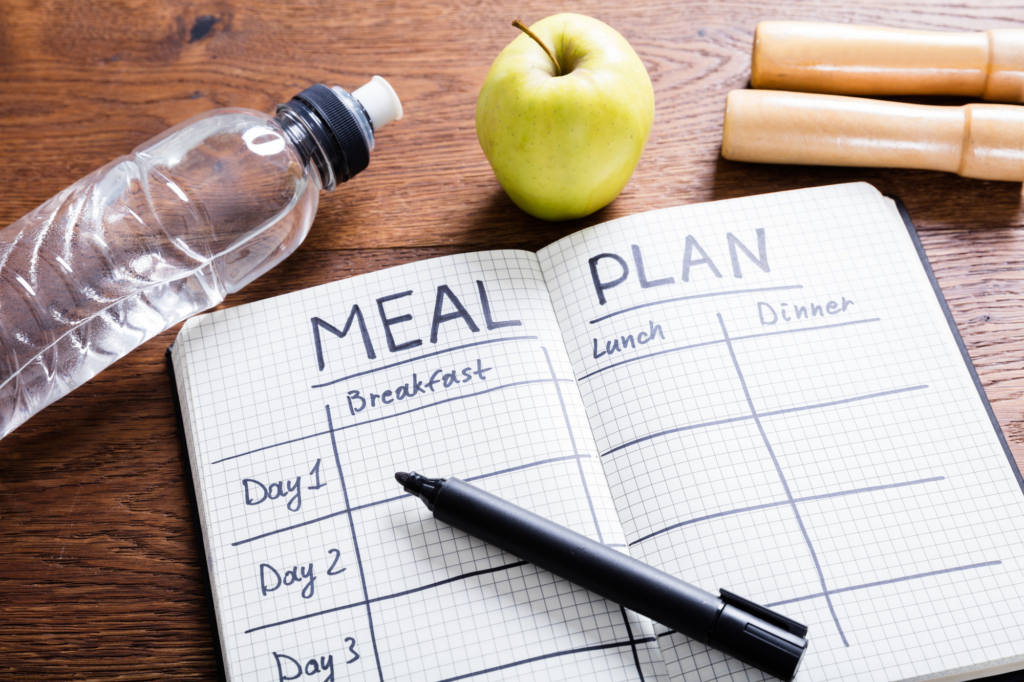
According to a National Health and Nutrition Examination Survey, almost half of American adults try to lose weight every year. These individuals report trying a variety of methods, including increasing exercise, changing their diets, or skipping meals altogether.
Despite their best efforts, however, most people will struggle to lose weight and keep it off.
That’s because you can’t find long-term success with short-term solutions. Instead, you need to make comprehensive lifestyle changes. Your daily meal plan, in particular, will determine how far your efforts will take you.
So today, we’ll look at how you can create the best meal plan for weight loss. Rather than giving you a one-size-fits-all meal plan, we’ll give you the tools needed to craft a personalized diet. We’ll also run down some examples of diets backed up by science.
We’ll start by looking at the foundations that make a weight-loss diet work.
Diet-Planning Basics
There’s one key component that all successful weight loss plans have in common. To start dropping those pounds, you need to burn more calories than you take in.
Disregard whatever miracle weight-loss scheme you might see advertised. At best, fad diets and supplements can only help you lose weight when combined with a healthy diet. At worst, some of these unregulated products can be dangerous.
Speaking of danger, while reducing your caloric intake is necessary to lose weight, you still need to take care to maintain a healthy diet. This means striking a balance between either burning or reducing enough calories to produce a deficit, while also still getting the key nutrients your body needs.
The most basic of these nutrients are what are called macronutrients, or “macros” for short. The three kinds of macros are protein, carbohydrates, and fats. Your body needs all three to function.
Some diets will call for you to eat a specific balance of macros. For instance, many diets suggest cutting down on carbs. Learning how to count your macros is key to these meal plans, and will help you make sure you’re getting enough of each regardless of the meal plan you use.
You also need to make sure that your body gets all the micronutrients it needs.
Micronutrients are the vitamins and minerals that different body systems need to function properly. Opting for a meal plan that includes plenty of healthy, nutrient-dense foods will help keep you feeling your best while losing weight.
Proven Types of Diets
You’ll find that the best weight-loss diet options will have a lot of core aspects in common. That’s because healthy, maintainable weight loss relies on a person’s ability to cut calories while still fueling their body.
We covered the basics of that strategy above. But seeing some examples of how it works in practice can help you come up with a plan that will work for you. Here are some of the most popular diet plans that are backed up by science.
The Mediterranean Diet
The Mediterranean diet enjoys the reputation as one of the best diets for all-around good health. It’s based on the kinds of cuisines that the people of Greece, southern Italy, and other nearby areas have lived on for centuries.
This diet includes plenty of fresh fruits and vegetables, whole grains, fish, nuts, and lentils. Foods like meat, dairy, and eggs are only supposed to be enjoyed in moderation. Red meat, in particular, should only be treated as an occasional indulgence.
The Mediterranean diet also puts a hard limit on many modern food products. These include refined grains, trans fats, added sugar, and processed foods. In other words, a Mediterranean diet should be made from natural, whole foods as much as possible.
This diet is linked to several positive health outcomes. These include decreased risks of certain cancers and other chronic diseases.
Because it relies on nutrient-dense foods like whole grains, nuts, and fish, it’s a great weight-loss choice as well. This diet lets you reduce the number of calories you eat while still allowing plenty of opportunities to get the nutrients your body needs.
The DASH Diet
The Dietary Approaches to Stop Hypertension (DASH) diet is a plan created to address high blood pressure. Like the Mediterranean diet, it places a lot of emphasis on fresh fruits and vegetables, lean proteins, and whole grains.
Though not a dedicated weight loss diet, many individuals report losing weight while using DASH. This makes sense, as obesity and high blood pressure are often comorbid. So addressing the root cause of one can often help manage the other.
Plant-Based and Flexitarian Diets
Many people report losing weight while eating plant-based diets. Of these, vegetarianism and veganism are the best-known diets. However, there are other options.
“Flexitarian” diets rely on plant products as their basis but do allow for animal products in moderation.
Like the other options mentioned, healthy plant-based diets are based on fresh produce, whole grains, and lean protein. In this case, protein from vegetable sources wherever possible.
Building the Best Meal Plan for Weight Loss
All of the aforementioned strategies have research backing up their efficacy. If any of them appeal to you in particular, you could use them as a basis to build your personal nutrition plan.
Many people struggle with strict routines, however. Variety is the spice of life, after all, so sticking to one iron-clad plan can prove challenging.
Instead, consider the key tenets that make each of those plans work and look for ways you can apply them to your lifestyle. The Mediterranean diet, for instance, puts a lot of emphasis on nutrient-dense whole foods. That’s why it’s great for maintaining good health even as you reduce your overall calorie intake.
This process can involve a lot of trial and error. It might involve you expanding your meal options and considering foods you’ve never tried before. And not every healthy option will be to your liking.
All the same, you need to come up with meals that you’ll enjoy eating. Going overboard and forcing yourself to live on meals you don’t like can be a stumbling block. It can cause you to slide back into bad habits at any stage of your journey and will make maintaining your healthy lifestyle changes almost impossible in the long term.
As you discover healthy new options, start integrating them into your routine.
Putting Your Plan Into Action
Coming up with delicious, nutritious, and low-calorie meals is the easy part, believe it or not. Where many people struggle is taking those meals and putting them into a routine.
There’s no getting around the fact that planning, shopping, and prepping all take time. It’s a key reason why we resort to takeout or fast food so often. So working around time constraints will be crucial to your success.
One common strategy is to prepare several large batches of food on days off work. Then on workdays when you’re pressed for time, all you need to do is parcel out your daily portions.
Others insist on preparing their meals fresh daily. In this case, handling all of your prep work in large batches is the best way to cut down on day-to-day kitchen time.
If you prefer more flexibility in your meal plan, then neither of these options may be optimal for you. In that case, handling your shopping in large batches can be one solution. This will let you stock your fridge and pantry with all the fresh, healthy ingredients you could need to whip up a healthy dish on the fly.
Warehouse stores like Costco or Sam’s Club are great for this approach. You can get a considerable discount for buying in bulk, and they carry a better selection of fresh, unprocessed foods than you might think. Just be sure to measure your portions at each meal.
Tips for Long-Term Success
One of the main reasons people break their diets is meal repetition. It doesn’t matter how healthy a dish is if you eat it so often that you can’t stand the sight of it. So to combat that, be sure to have enough recipes in your playbook to keep your mealtimes exciting.
Social engagements are another common stumbling block. It’s not always possible to forgo working lunches, date nights, or brunch with friends.
One “cheat meal” a week isn’t enough to derail your weight loss plan. But if you know in advance that you have several events coming up, you may need to plan the rest of your week around that to stay on target.
Last, you need not fear the occasional snack. Letting yourself get overly hungry is a sure way to strain your willpower. It’s better to keep a few healthy snacks on hand than to find yourself breaking your diet entirely.
Maintaining a Healthy Diet in the Long Run
Weight loss is a marathon, not a sprint. Too often, someone will hit their short-term goals, only to slide back into old habits. That’s why only about 20% of Americans who lose weight can keep it off.
You don’t have to walk that road alone, however.
The Athleticus is committed to building a healthier community, one fitness journey at a time. By joining us, you’ll gain a support system that can help keep you on the right track. So if you’re ready to become the best version of yourself, schedule a “no sweat intro” with us today.



